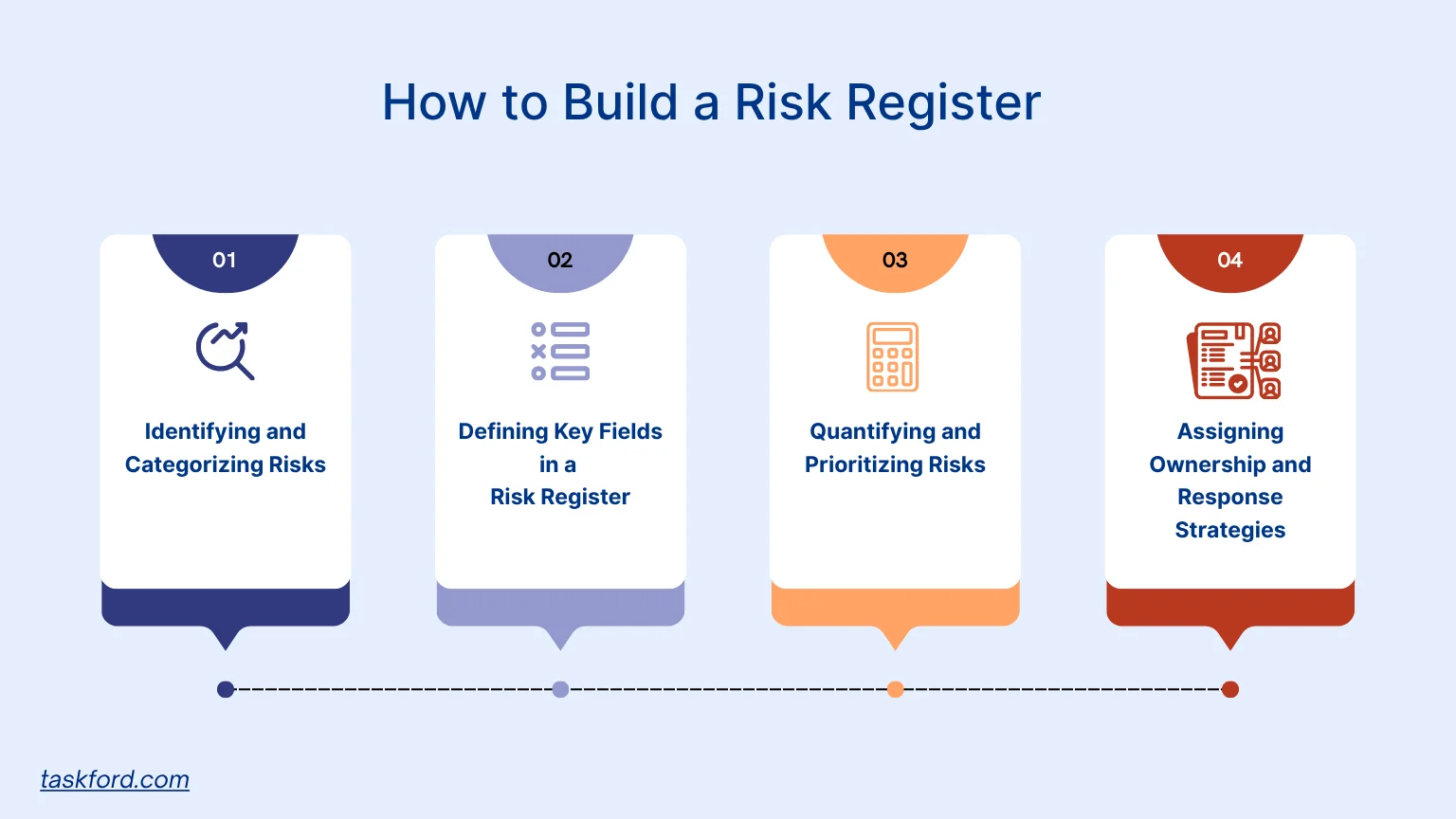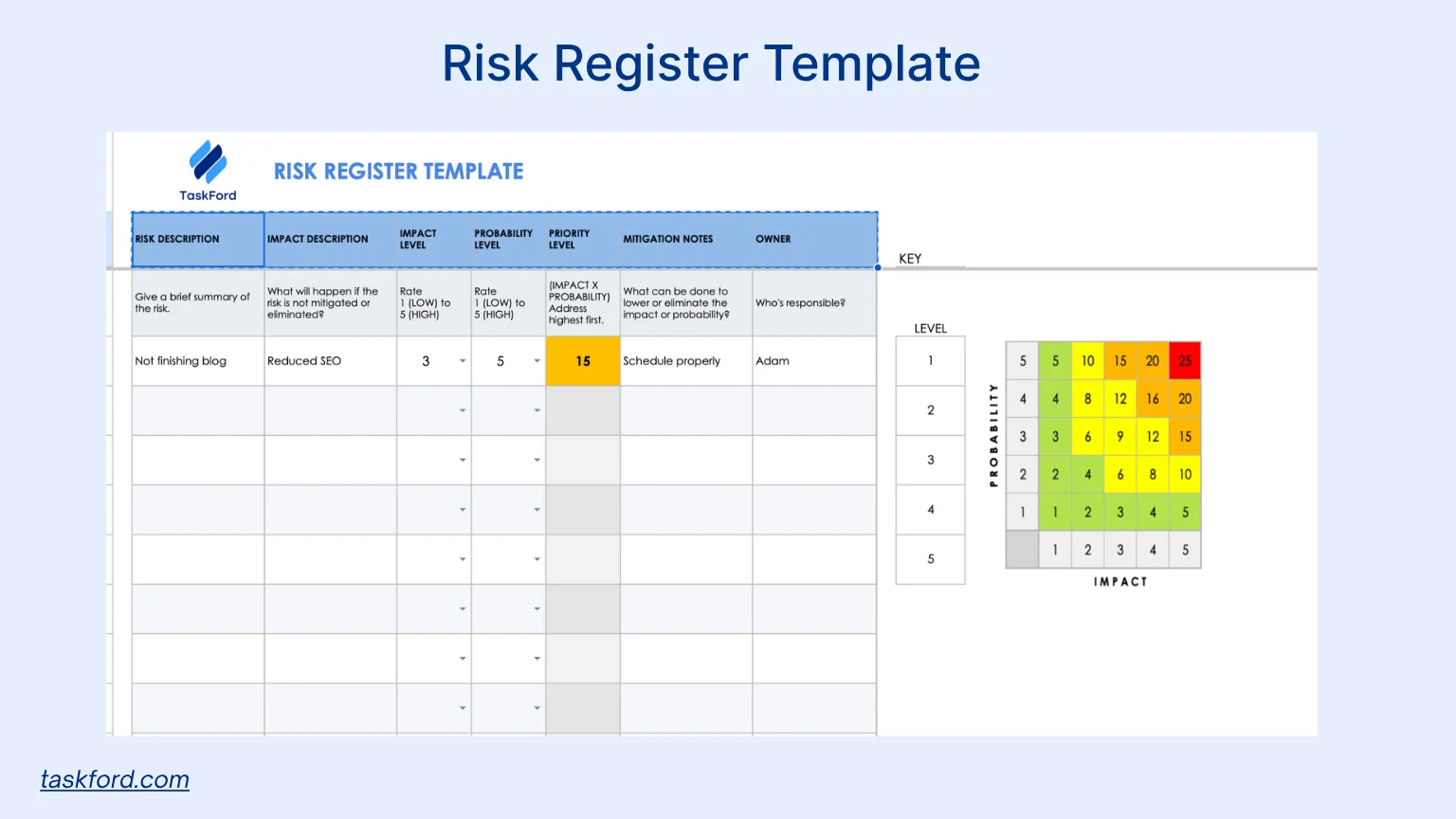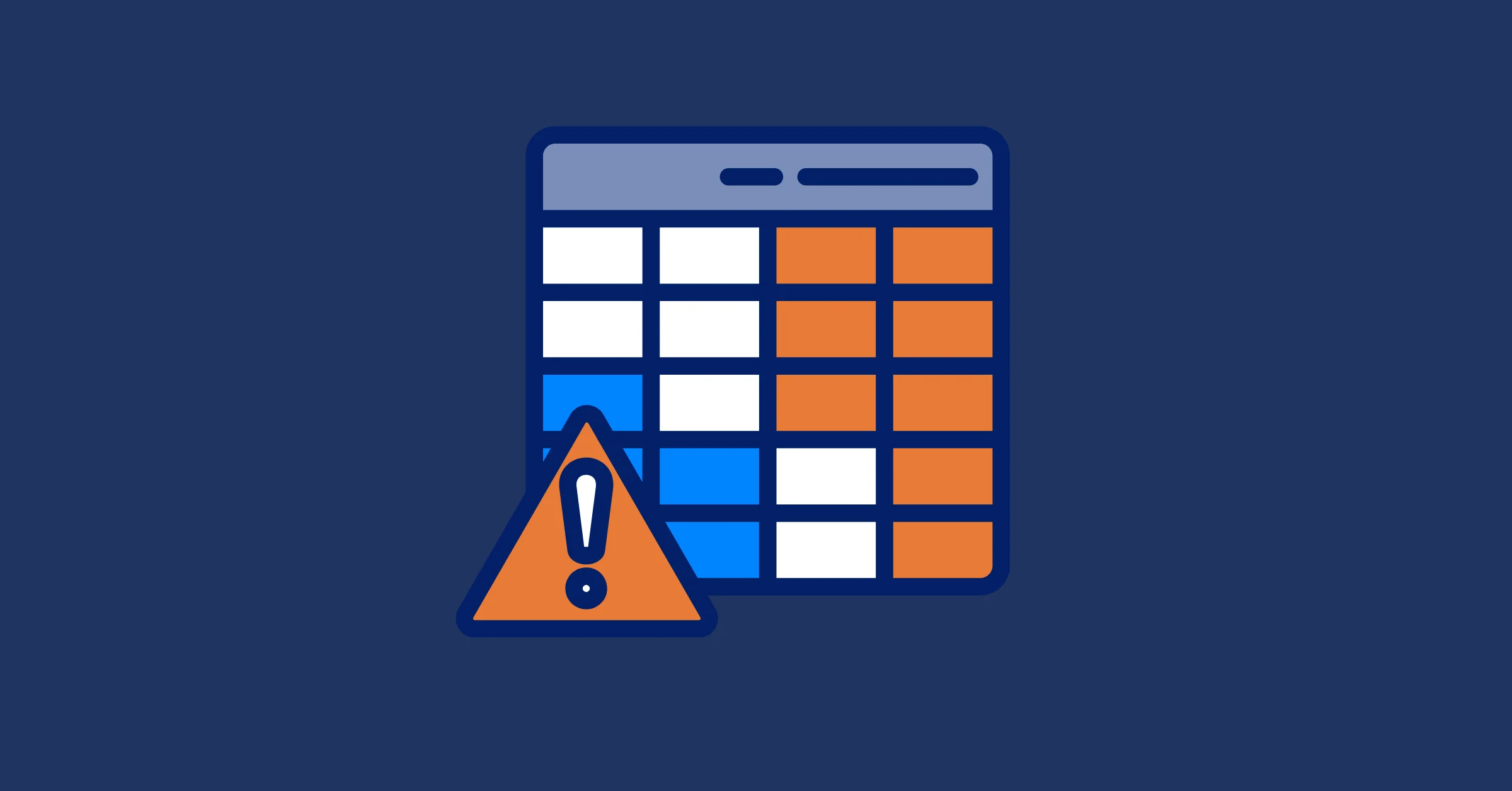How To Build and Maintain a Risk Register
Build and maintain a risk register that strengthens your risk management plan, prioritizes project risks, and drives smarter, more confident project decisions.
Managing project risks is never about avoiding problems entirely. It is about anticipating uncertainty, evaluating potential outcomes, and preparing structured responses before issues grow into setbacks. A well-developed risk register transforms this process from guesswork into disciplined strategy.
For advanced project managers and PMOs, a risk register is more than a checklist. It is a living document that connects data, decisions, and accountability. When maintained correctly, it enables teams to focus resources on what truly matters, protecting project objectives while supporting organizational resilience.
This guide explains how to build and maintain a risk register that serves as both a practical tool and a strategic system for continuous improvement.
What Is a Risk Register and Why It Matters
A risk register is a structured document or digital tool that records, assesses, and tracks potential threats to a project or organization. It typically forms part of a broader risk management plan, serving as the operational heart of risk control.
At its core, a risk register helps teams identify possible project risks, evaluate their impact and likelihood, and assign actions or ownership to mitigate them. It offers a transparent view of the risk landscape, enabling managers to allocate attention and resources effectively.
Key Purposes of a Risk Register
- Visibility: Keeps all known risks in one central location for easy monitoring.
- Accountability: Ensures every risk has an assigned owner and response plan.
- Decision Support: Provides structured data to guide prioritization and contingency planning.
- Continuous Learning: Captures lessons from past risks to improve future performance.
When consistently maintained, a risk register becomes the foundation for organizational learning and proactive decision-making. It also demonstrates to stakeholders that project risks are being managed professionally, in line with industry standards like Project Management Institute’s PMBOK.
How to Build a Risk Register

A risk register should not be treated as a static log. It must evolve as the project moves through different phases, capturing both new risks and updates to existing ones. Below are the essential steps for building a risk register that provides depth, structure, and long-term value.
Step 1: Identifying and Categorizing Risks
The first stage involves discovering what could go wrong, or right within the project. Risks can arise from multiple sources: internal decisions, resource constraints, external market shifts, regulatory changes, or technology limitations.
Advanced identification techniques include:
- Brainstorming sessions with cross-functional teams.
- Historical data analysis from past projects.
- Scenario planning to anticipate potential changes in the environment.
- Monte Carlo simulation to quantify uncertainty using probability distributions.
- Delphi method to refine expert opinions and converge on key risk factors.
Once identified, you can also categorize risks into groups such as: Strategic, Operational, Financial, Technical, Legal, Environmental, Reputational. Categorization helps in visualizing patterns and addressing root causes rather than isolated symptoms.
Step 2: Defining Key Fields in a Risk Register
A strong risk register depends on the quality of the information it captures. The structure should balance simplicity and detail. Each entry must contain standardized fields that make comparison and reporting easy.
Here are the essential fields every risk register should include:
| Field | Purpose |
|---|---|
| Risk Description | A concise statement outlining the nature of the risk. |
| Impact Description | A clear explanation of how the risk could affect objectives, schedules, or budgets. |
| Impact Level | Rated as Low, Medium, or High, or on a numerical scale (e.g., 1–5). |
| Probability Level | Likelihood of occurrence, using the same rating or scale. |
| Priority Level | Derived from combining impact and probability; indicates urgency or importance. |
| Mitigation Notes | Lists preventive or corrective actions, control measures, or fallback plans. |
| Owner | The person or team responsible for monitoring and implementing mitigation strategies. |
This consistent structure helps ensure that every project risk is recorded with clarity and accountability. Over time, the data collected in these fields also enables trend analysis and predictive insights.
Step 3: Quantifying and Prioritizing Risks
Not all risks are equal. Some may have a minor effect, while others can jeopardize the entire project. Quantifying risk is therefore a crucial step in risk management planning.
Start with qualitative methods, such as a Probability–Impact Matrix, to assign scores based on expert judgment. Then, where data is available, move toward quantitative techniques like:
- Expected Monetary Value (EMV): Calculates potential financial impact by multiplying probability by cost.
- Risk Exposure Value: Measures combined risk impact across multiple categories.
- Sensitivity Analysis: Evaluates which variables influence project outcomes the most.
- The most common way to quantify Priority is to multiply Probability with Impact
Visual tools such as heat maps or Pareto charts make it easier to communicate priority risks to stakeholders. These visuals provide an at-a-glance understanding of which risks require immediate attention and which can be monitored periodically.
Step 4: Assigning Ownership and Response Strategies
Every risk must have a clearly defined owner. This person ensures that mitigation activities are executed and progress is reported. Assigning ownership also reinforces accountability and improves follow-through.
Response strategies can vary depending on the nature and severity of the risk:
- Avoid: Change project scope or approach to eliminate the risk entirely.
- Mitigate: Reduce the probability or impact through preventive action.
- Transfer: Shift responsibility through contracts, insurance, or outsourcing.
- Accept: Acknowledge the risk and prepare contingency plans.
- Exploit: In cases of positive risks, take advantage of potential opportunities.
Integrate response actions with your project plan so that mitigation efforts are visible in task schedules, budgets, and resource allocations.
How to Maintain a Risk Register
Building the risk register is only half the work. Maintaining it ensures that risk information remains accurate, timely, and relevant throughout the project lifecycle.
Set a Review Frequency
The frequency of reviews depends on project complexity and volatility. For high-risk or fast-moving projects, weekly updates may be appropriate. For longer or more stable projects, monthly reviews or milestone-based evaluations may suffice.
Regular reviews ensure that no new risks go unnoticed and that mitigation actions remain effective.
Update Risk Data Continuously
As conditions change, update Impact Level, Probability Level, and Priority Level values. New risks should be added immediately, while obsolete or resolved ones should be archived.
Regular updates also prevent data decay, a common problem in static or neglected registers. Keeping the Risk Register current makes it a reliable foundation for real-time decision-making.
Track Mitigation Progress
Mitigation plans are not one-time actions. The mitigation notes section should be updated to reflect the current status, effectiveness of controls, or any additional measures taken.
After implementing mitigation strategies, reassess residual risk to verify whether further action is required. This continuous loop of evaluation is what transforms a Risk Register into a truly dynamic management tool.
Communicate and Escalate
Not all risks can or should be handled at the project level. Define escalation thresholds for when a risk exceeds acceptable tolerance levels or falls outside a team’s authority.
Provide concise summaries or visual dashboards for higher management. Tools like risk heat maps, trend charts, and cumulative exposure graphs help executives see patterns and make informed decisions without wading through dense documentation.
Risk Register Template

After following these steps, your risk register should look simple but still comprehensive like this template for clear visualization and communication among your team.
How to Digitize and Automate a Risk Register
Modern project environments demand real-time visibility and integrated collaboration. A digital risk register allows teams to update, analyze, and report on risks efficiently.
Benefits of Digital Risk Registers
- Centralized access for all stakeholders.
- Real-time updates and notifications.
- Automated scoring and prioritization.
- Version control and data security for audits.
Tool Cooperation
A risk register becomes far more powerful when integrated into your existing project management ecosystem. Tools such as TaskFord can be used long with a risk register allow direct linkage between risk entries and project tasks. This ensures that mitigation actions are visible in scheduling and resource planning.
Automation and Analytics
Automation can take over repetitive tasks like recalculating risk exposure values or sending reminders for review deadlines. Advanced analytics can analyze historical project risks to detect recurring patterns or predict future threats.
For mature organizations, integrating machine learning capabilities enables risk forecasting based on real data trends. This moves risk management from being reactive to predictive.
Embed a Risk Register into Organizational Culture
The true value of a Risk Register emerges when it becomes part of the organization’s culture rather than a compliance requirement.
- Encourage Open Communication: Team members should feel comfortable reporting potential project risks without fear of blame. This openness creates an early-warning system where problems are identified before they escalate.
- Training and Capability Building: Equip teams with the skills to identify and assess risks accurately. Regular workshops and refreshers ensure consistent understanding of risk terminology, scoring methods, and mitigation planning.
- Recognition and Accountability: Recognize individuals who proactively manage or surface critical risks. This reinforces positive behavior and makes risk management a shared responsibility rather than a bureaucratic task.
- Continuous Learning: Archive completed project risk registers to create a risk knowledge base. Analyzing past risks and mitigation outcomes provides valuable insights for future projects. Lessons learned help refine your risk management plan and improve overall organizational maturity.
Advanced Risk Register Practices
As your organization’s risk maturity grows, enhance your Risk Register with advanced practices that improve foresight and strategic alignment.
- Link multiple risk registers across projects or departments to build an enterprise-level risk view.
- Use trend analysis to detect recurring risks and emerging themes.
- Conduct premortem sessions before project launch to anticipate failures early.
- Leverage predictive analytics to model the potential impact of interconnected risks.
- Develop a “risk intelligence repository” where insights, scenarios, and outcomes are stored for ongoing learning.
These approaches elevate the Risk Register from an operational record to a strategic asset that informs decision-making across the organization.
Common Risk Register Mistakes to Avoid
Even experienced teams can fall into traps that undermine the effectiveness of their risk register. Avoid these frequent pitfalls:
- Treating the register as static instead of updating it regularly.
- Ignoring residual risks after mitigation.
- Overcomplicating scoring systems that confuse rather than clarify.
- Failing to assign ownership, leaving risks unmonitored.
- Neglecting communication, resulting in disconnected project stakeholders.
A risk register must remain simple enough to use daily, yet robust enough to handle complex project environments.
Conclusion
A well-constructed and consistently maintained Risk Register is far more than an administrative formality. It is the backbone of a mature risk management plan, enabling organizations to anticipate challenges, protect value, and capitalize on opportunities.
By combining structured data with continuous updates, digital integration, and a culture of accountability, teams can transform their approach to managing project risks. When done right, the risk register becomes more than a record, it becomes a strategic instrument that drives project success and strengthens organizational resilience.
Learn more
- What Is Project Management? A Beginner’s Comprehensive Guide 2026
- What Does A Project Manager Do? A Guide to Advancing Your Career
- 80 Key Project Management Terms You Should Know
Making work simpler,
smarter, and more connected
Join our waitlist and be notified first.

Related Blog
Subscribe for Expert Tips
Unlock expert insights and stay ahead with TaskFord. Sign up now to receive valuable tips, strategies, and updates directly in your inbox.






